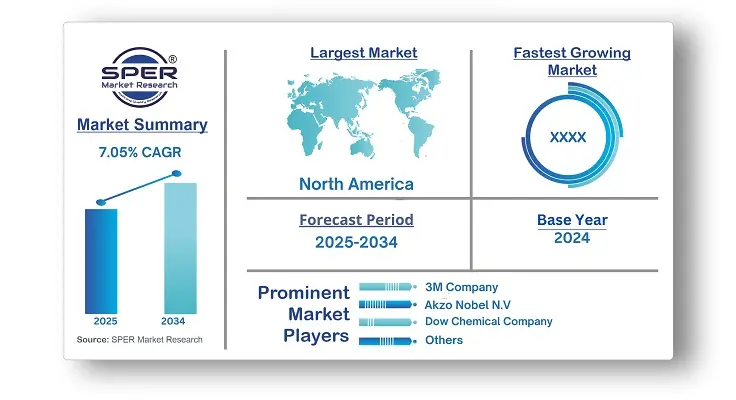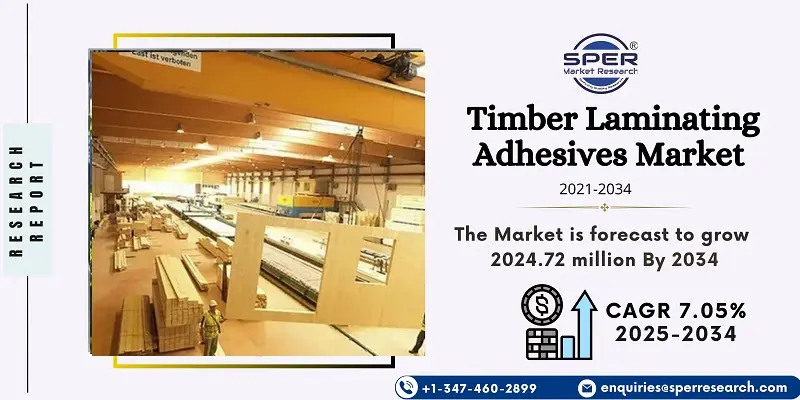Timber Laminating Adhesives Market Introduction and Overview
According to SPER Market Research, the Global Timber Laminating Adhesives Market is estimated to reach USD 2024.72 million by 2034 with a CAGR of 7.05%.
The report includes an in-depth analysis of the Global Timber Laminating Adhesives Market, including market size and trends, product mix, Applications, and supplier analysis. The Timber Laminating Adhesives Market was valued at around USD 1024.47 million in 2024 and is expected to grow at a rate of over 7.05% from 2025 to 2034. The market is growing due to factors like the rising construction and furniture industries and the need for sustainable materials. Laminating adhesives are important for the strength of engineered timber products, while the furniture industry's preference for laminated timber supports further growth.
By Resin Type Insights
Melamine formaldehyde adhesives have led the market in 2024 because they are cheaper and offer moderate bonding strength, making them suitable for less demanding uses in furniture and construction. Polyurethane adhesives are also being used more often due to their versatility and moisture resistance. Emulsion polymer isocyanate adhesives are gaining traction for their fast-curing times and low emissions, appealing to those seeking eco-friendly options.
By Application Insights
Floor beams hold a large part of the market due to the common use of laminated timber for its strength, durability, and design flexibility. Window and door headers are also important applications, as laminated timber can bear heavy loads and improve stability, especially in residential and commercial buildings. Trusses and supporting columns are other key areas where laminated timber provides a lightweight and strong support for structures.
Laminated timber is also used in transportation, marine, and industrial sectors, adding to market share. While floor beams, roof beams, and trusses are main segments, new applications are developing through innovations in timber engineering and building techniques, with a focus on sustainability likely to increase laminated timber's use in various applications.
By End-User Insights
In 2024, residential construction is anticipated to hold the biggest market share, and it is anticipated to expand considerably until 2034. This growth is driven by the increasing use of timber as a sustainable and attractive building material in homes. Commercial applications are also important, using laminated timber in offices, retail, and hospitality buildings due to its versatility and cost-effectiveness.
Regional Insights
In 2024, North America held a dominant position in the timber laminating adhesives market. Laminating adhesives are in high demand because of the U.S. construction industry's desire for engineered timber products, such as laminated lumber. Additionally, the demand for these adhesives is greatly increased by the U.S. furniture business. The market is expected to increase in the United States due to factors such as improvements in adhesive formulations, stringent regulations for environmentally friendly products, and the growing trend of sustainable construction methods. However, variations may exist in North America due to local regulations, climate, and economic conditions. Overall, the U. S. market holds a significant share, with expansion opportunities linked to infrastructure development and sustainable building awareness.
Market Competitive Landscape
The timber laminating adhesives industry is moderately fragmented, with numerous main manufacturers competing for market share. Henkel AG & Co. KGaA, H.B. Fuller Company, 3M Company, Sika AG, and Akzo Nobel N.V. are among the leading players in this market. Each of these organisations brings distinct strengths and product offerings to the table, catering to a wide range of customer demands and preferences. Furthermore, Bostik SA (Arkema Group), Dow Chemical Company, Huntsman Corporation, LORD Corporation, and Ashland Global Holdings Inc. all make substantial contributions to the market's competitive dynamics, broadening the spectrum of accessible solutions.
Recent Developments:
In December 2024, Arkema strengthened its position in North America and Europe by paying $250 million to acquire Dow's flexible packaging laminating adhesives division. With a $50 million integration investment and an anticipated $30 million in benefits over five years, the acquisition is anticipated to strengthen Arkema's position in environmentally friendly packaging adhesives.
In June 2023, Henkel AG held a groundbreaking ceremony for its new manufacturing adhesive-based business unit in Shandong Province, China. The new factory, named 'Kunpeng,' will cost approximately USD 126 million. The facility would strive to address rising demand and Henkel's consumer base by optimising the supply network in Asia Pacific and international markets.
Scope of the report:
| Report Metric | Details |
| Market size available for years | 2021-2034 |
| Base year considered | 2024 |
| Forecast period | 2025-2034 |
| Segments covered | By Resin Type, By Application, By End-User |
| Regions covered | North America, Latin America, Asia-Pacific, Europe, and Middle East & Africa |
| Companies Covered | 3M Company, Akzo Nobel N.V, Bostik SA (Arkema Group), Dow Chemical Company, H.B. Fuller Company, Henkel AG & Co. KGaA, Sika AG.
|
Key Topics Covered in the Report
- Global Timber Laminating Adhesives Market Size (FY’2021-FY’2034)
- Overview of Global Timber Laminating Adhesives Market
- Segmentation of Global Timber Laminating Adhesives Market By Resin Type (Melamine Formaldehyde, Phenol Resorcinol Formaldehyde Adhesives, Polyurethane, Emulsion Polymer Isocyanate Adhesives)
- Segmentation of Global Timber Laminating Adhesives Market By Application (Floor beams, Roof beams, Window and door headers, Trusses and supporting columns, Others)
- Segmentation of Global Timber Laminating Adhesives Market By End User (Residential, Commercial, Industrial, Institutional, Others)
- Statistical Snap of Global Timber Laminating Adhesives Market
- Expansion Analysis of Global Timber Laminating Adhesives Market
- Problems and Obstacles in Global Timber Laminating Adhesives Market
- Competitive Landscape in the Global Timber Laminating Adhesives Market
- Details on Current Investment in Global Timber Laminating Adhesives Market
- Competitive Analysis of Global Timber Laminating Adhesives Market
- Prominent Players in the Global Timber Laminating Adhesives Market
- SWOT Analysis of Global Timber Laminating Adhesives Market
- Global Timber Laminating Adhesives Market Future Outlook and Projections (FY’2025-FY’2034)
- Recommendations from Analyst
1. Introduction
1.1. Scope of the report
1.2. Market segment analysis
2. Research Methodology
2.1. Research data source
2.1.1. Secondary Data
2.1.2. Primary Data
2.1.3. SPER’s internal database
2.1.4. Premium insight from KOL’s
2.2. Market size estimation
2.2.1. Top-down and Bottom-up approach
2.3. Data triangulation
3. Executive Summary
4. Market Dynamics
4.1. Driver, Restraint, Opportunity and Challenges analysis
4.1.1. Drivers
4.1.2. Restraints
4.1.3. Opportunities
4.1.4. Challenges
5. Market variable and outlook
5.1. SWOT Analysis
5.1.1. Strengths
5.1.2. Weaknesses
5.1.3. Opportunities
5.1.4. Threats
5.2. PESTEL Analysis
5.2.1. Political Landscape
5.2.2. Economic Landscape
5.2.3. Social Landscape
5.2.4. Technological Landscape
5.2.5. Environmental Landscape
5.2.6. Legal Landscape
5.3. PORTER’s Five Forces
5.3.1. Bargaining power of suppliers
5.3.2. Bargaining power of buyers
5.3.3. Threat of Substitute
5.3.4. Threat of new entrant
5.3.5. Competitive rivalry
5.4. Heat Map Analysis
6. Competitive Landscape
6.1. Global Timber Laminating Adhesives Market Manufacturing Base Distribution, Sales Area, Product Type
6.2. Mergers & Acquisitions, Partnerships, Product Launch, and Collaboration in Global Timber Laminating Adhesives Market
7. Global Timber Laminating Adhesives Market, By Resin type (USD Million) 2021-2034
7.1. Melamine formaldehyde
7.2. Phenol resorcinol formaldehyde adhesives
7.3. Polyurethane
7.4. Emulsion polymer isocyanate adhesives
7.5. Others
8. Global Timber Laminating Adhesives Market, By Application (USD Million) 2021-2034
8.1. Floor beams
8.2. Roof beams
8.3. Window and door headers
8.4. Trusses and supporting columns
8.5. Others
9. Global Timber Laminating Adhesives Market, By End-User (USD Million) 2021-2034
9.1. Residential
9.2. Commercial
9.3. Industrial
9.4. Institutional
9.5. Others
10. Global Timber Laminating Adhesives Market, (USD Million) 2021-2034
10.1. Global Timber Laminating Adhesives Market Size and Market Share
11. Global Timber Laminating Adhesives Market, By Region, (USD Million) 2021-2034
1.1. Asia-Pacific
11.1.1. Australia
11.1.2. China
11.1.3. India
11.1.4. Japan
11.1.5. South Korea
11.1.6. Rest of Asia-Pacific
11.2. Europe
11.2.1. France
11.2.2. Germany
11.2.3. Italy
11.2.4. Spain
11.2.5. United Kingdom
11.2.6. Rest of Europe
11.3. Middle East and Africa
11.3.1. Kingdom of Saudi Arabia
11.3.2. United Arab Emirates
11.3.3. Qatar
11.3.4. South Africa
11.3.5. Egypt
11.3.6. Morocco
11.3.7. Nigeria
11.3.8. Rest of Middle-East and Africa
11.4. North America
11.4.1. Canada
11.4.2. Mexico
11.4.3. United States
11.5. Latin America
11.5.1. Argentina
11.5.2. Brazil
11.5.3. Rest of Latin America
12. Company Profile
12.1. 3M Company
12.1.1. Company details
12.1.2. Financial outlook
12.1.3. Product summary
12.1.4. Recent developments
12.2. Akzo Nobel N.V
12.2.1. Company details
12.2.2. Financial outlook
12.2.3. Product summary
12.2.4. Recent developments
12.3. Bostik SA (Arkema Group)
12.3.1. Company details
12.3.2. Financial outlook
12.3.3. Product summary
12.3.4. Recent developments
12.4. Dow Chemical Company
12.4.1. Company details
12.4.2. Financial outlook
12.4.3. Product summary
12.4.4. Recent developments
12.5. H.B. Fuller Company
12.5.1. Company details
12.5.2. Financial outlook
12.5.3. Product summary
12.5.4. Recent developments
12.6. Henkel AG & Co. KGaA
12.6.1. Company details
12.6.2. Financial outlook
12.6.3. Product summary
12.6.4. Recent developments
12.7. Sika AG
12.7.1. Company details
12.7.2. Financial outlook
12.7.3. Product summary
12.7.4. Recent developments
12.8. Others
13. Conclusion
14. List of Abbreviations
15. Reference Links
SPER Market Research’s methodology uses great emphasis on primary research to ensure that the market intelligence insights are up to date, reliable and accurate. Primary interviews are done with players involved in each phase of a supply chain to analyze the market forecasting. The secondary research method is used to help you fully understand how the future markets and the spending patterns look likes.
The report is based on in-depth qualitative and quantitative analysis of the Product Market. The quantitative analysis involves the application of various projection and sampling techniques. The qualitative analysis involves primary interviews, surveys, and vendor briefings. The data gathered as a result of these processes are validated through experts opinion. Our research methodology entails an ideal mixture of primary and secondary initiatives.





































